The sea turtles are gentle reptiles that spend most of their lifespan underwater. There are seven modern sea turtles, and all belong to the Testudines order.
As reptiles, they also need to lay eggs and air to breathe. Therefore, to adapt to the marine and land conditions, they have unique features such as a resilient and streamlined shell that enables them to maneuver easily through their marine habitats.
These long-lived species have breath-holding abilities, which allow them to dive deep in the ocean and catch prey. Female sea turtles reproduce through nesting.
During the nesting season, they migrate ashore mostly at night to lay clutches of eggs. Each nest can hold an average of 110 eggs although, the exact amount depends on the species.
The eyes of the Ocean turtles have flat corneas and an almost flat spherical lens for both the aquatic and air environments. They seem a little near-sighted on land but perfectly sighted while in the oceans.
Sometimes these sea turtles are unable to balance their temperatures. Therefore, they become cold-stunned and unable to swim. Waters will then wash them ashore where they die unless people notice and re-establish them.
Sea turtles take decades to survive until sexual maturity. When they are sexually mature, they mate in the sea before the females migrate to the shore where they were born to lay their eggs in sandpits. Their eggs take an average of 2 months to develop for hatching. During certain stages of development, the temperatures of each egg determine the gender of the baby sea turtle.
The Cooler eggs produce males while warmer ones generate female turtles. After hatching, these hatchlings use the shining light source to head towards the Oceans.
Families of the Marine Turtles
There are four families under the sea turtles. They are; Cheloniidae, Dermochelyidae, Toxochelyidae, and Protostegidae. Members of the Toxochelyidae and Protostegidae families become extinct during the Cretaceous period, 66 million years ago during the asteroid event.
Cheloniidae family has only one species left, the leatherback, while Dermochelyidae has seven sea turtles that survived extinction.
Protostegidae
Members of this family went extinct 66 million years ago. It includes some of the giant sea turtles ever to exist. Archelon belongs to this family. Other species include Santanachelys, who lived 110 million years ago with a 20 cm long body, and the protostegids.
The protostegids were the first marine turtles under this family. Therefore, they laid out the general body shape for other future species after them. Their body shape included:
- A smaller body.
- Four limbs.
- A shorter tail.
- A short neck with a relatively large head.
They also possessed sharp peaks and extremely reduced carapaces that would later evolve to be the largest, as seen in Archelon.
They majorly lived in the Western Interior Sea. Archaeologists often find their limbs and fragile parts missing from their fossil skeletons. This means that they were the common prey of the late Cretaceous predators.
Further studies have shown that their skulls might have been adapted to consume hard-shelled mollusks such as inoceramid clams from the bottom of the seafloor.
Family Overview
- Phylum: Chordata
- Class: Sauropsida
- Order: Testudines
- Common Name: Sea turtle
- Habitat: epifaunal
- Feeding Mode: Predator
Modern Marine Turtles Species
1. The Leatherback Sea turtle
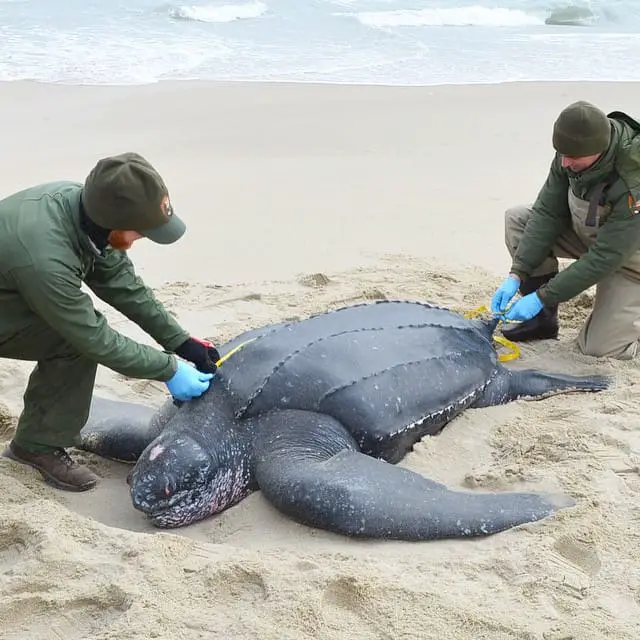
It’s the only living species under the Dermatochelyidae family. Unlike the other marine turtles, it is made of a thick leathery carapace, can survive colder waters, and dive deeper. They spend most of their lives in the deep open ocean.
Their shells are streamlined with seven protruding ridges to enhance their deep dive. The ridges are called keels, and they run along with the carapace from head to tail.
These ridges reduce drags alongside very long flippers that power the turtles rapidly through the water.
These species exist mainly in the Atlantic, Pacific, and Indian oceans. The tropical latitudes across the world encompass their nesting beaches. Their significant remaining nesting spots are in Trinidad and Tobago, Gabon, Africa, and West Indies.
Leatherbacks sea turtles migrate thousands of distances to feed and breed globally. They have traveled the longest of distances compared to other sea turtles and even other marine reptiles. One leatherback traveled for over 12,000 miles to the Western Coast of the USA.
Species Overview
- Order: Testudines
- Sub Order: Cryptodira
- Family: Dermatochelyidae
- Scientific Name: Dermochelys coriaceaWeight: 660 – 1,100 pounds (300 – 500 kg).
- Size: 4- 6 feet (130 – 183 cm).
- Population Estimate: roughly 34,000 – 36,000 nesting females
- Diet: Jellyfish mostly
- Threats to survival: commercial fisheries and marine pollution (such as balloons and plastic bags floating in the water, which are mistaken for jellyfish)
2. Green Sea Turtle
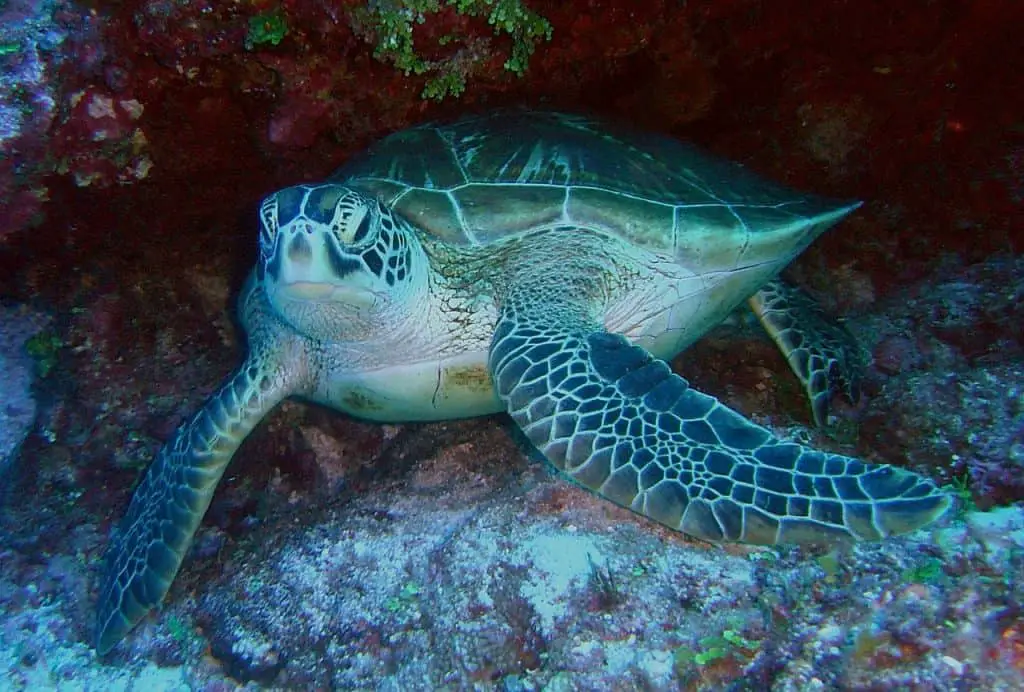
This species is the largest of the Sea turtles with hard shells that derive their name from their body fat. The adult versions are herbivorous, i.e., they feed on marine plants that make their body fat turn green. The hatchings don’t grow as herbivores since they feed on great fish eggs, mollusks and crustaceans.
They exist in Tropical and subtropical waters across the World. The adult ones spend most of their time near the Coast where the marine plants are ample. They have a single pair of prefrontal scales, which makes them different from the other sea turtles with two sets.
They mate every three to four years in the shallow waters close to the beach. Afterward, the females migrate offshore to lay their eggs in a sandpit. They dig the pits using their flippers and then fill them with approximately 100 to 210 eggs, cover them and head back to the seas.
Species Overview
- Order : Testudines
- Family: Cheloniidae
- Scientific name: Chelonia mydas
- Weight: roughly 300 and 350 pounds (136 to 159 kg)
- Size: Approximately (0.7 to 1.4 m)
- Population Estimate: Between 85,000 – 90,000 nesting females
- Diet: Seagrasses, seaweeds, algae and marine plant life
- Threats to Survival: Harvest of their Eggs and Human consumption
- Status: endangered on the IUCN’s Red List.
3. Loggerheads Sea turtle
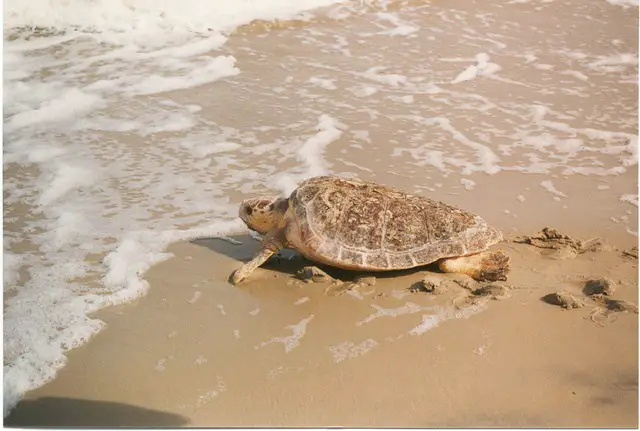
The loggerheads are one of the most widespread turtles located in temperate and tropical waters of the Pacific, Atlantic, and Indian Oceans. Their heads are huger compared to their bodies, thus their name.
The adults employ their large, strong jaws to crush their preferred prey- shellfish. Scientific studies have proven that both hatching and juvenile loggerhead can hear and respond to low-frequency sounds.
They are most common in the USA. Their hatchlings move towards the open sea, unlike other sea turtles whose young ones linger near the coastlines. A matured loggerhead spends most of his time looking for a feeding spot.
They have a heart-shaped carapace that’s red-brown. These sea turtles are “keystone species” since other species in the ecosystem depend on them for their survival. They digest invertebrates and then release excretions that contain calcium minerals for other species at the bottom of the seas.
Species Overview
- Order : Testudines
- Sub Order: Cryptodira
- Family: Cheloniidae
- Scientific name: Caretta caretta
- Weight: 230 to 350 pounds (104 to 170 kg)
- Size: 2.3 to 3.6 feet long (0.7 to 1.1 m)
- Population Estimate: Between 40,000 and 50,000 nesting females
- Diet: shellfish, crabs, conchs, and whelks.
- Threats to Survival: Entanglement in fishing gear.
- Status: Listed as endangered according to IUCN’s Red List.
4. Kemp Ridley Sea turtle
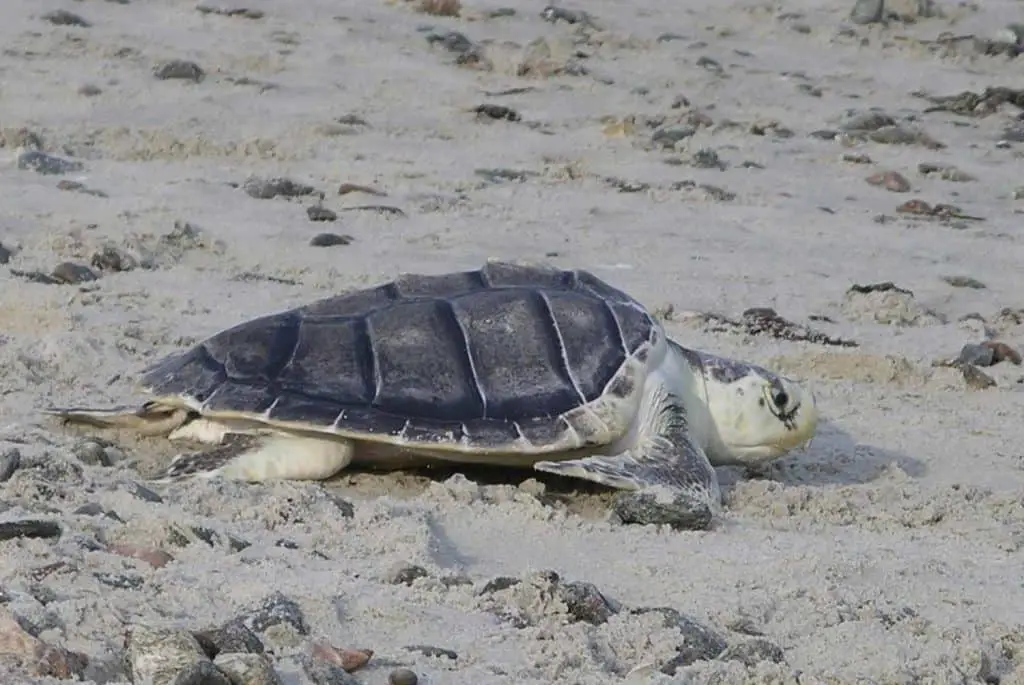
Scientists named these ocean turtles after Richard Kemp, a fisherman who was the first to identify and describe them in 1906. They have a comparatively small body and are the minimum common ocean turtles in the seas- approximately 2500 nesting females. They mainly live in the waters of the Northwest Atlantic and the Gulf of Mexico.
Kemp Ridleys are the only species that regularly nest during the daytime. Their small population makes the females nest in one area, the Rancho Nuevo beach on the shore of the Gulf of Mexico. The females usually gather in great Arribadas during nesting to protect themselves from predators.
The hatchlings have dark colors on the sides, while the adults have a shell that’s grayish-green on top and yellowish on the bottom. These creatures feed on crabs, jellyfish, and other mollusks but, their favorite is crabs.
Species Overview
- Order: Testudines
- Suborder: Cryptodira
- Family: Cheloniidae
- Scientific Name : Lepidochelys kempii
- Weight: approximately 70 to 100 pounds (32 to 45 kg)
- Size : about 2 feet (600 cm)
- Population Estimate: Approximately 7000 – 9000 nesting females
- Diet: Crabs
- Threats of Survival: Climate change, direct harvest by humans for their eggs and meat, Ocean and Seas pollution, and degradation of nesting habitats.
- Status: Considered critically endangered in the IUCN’s Red List.
5. Australian Flatback Sea turtle
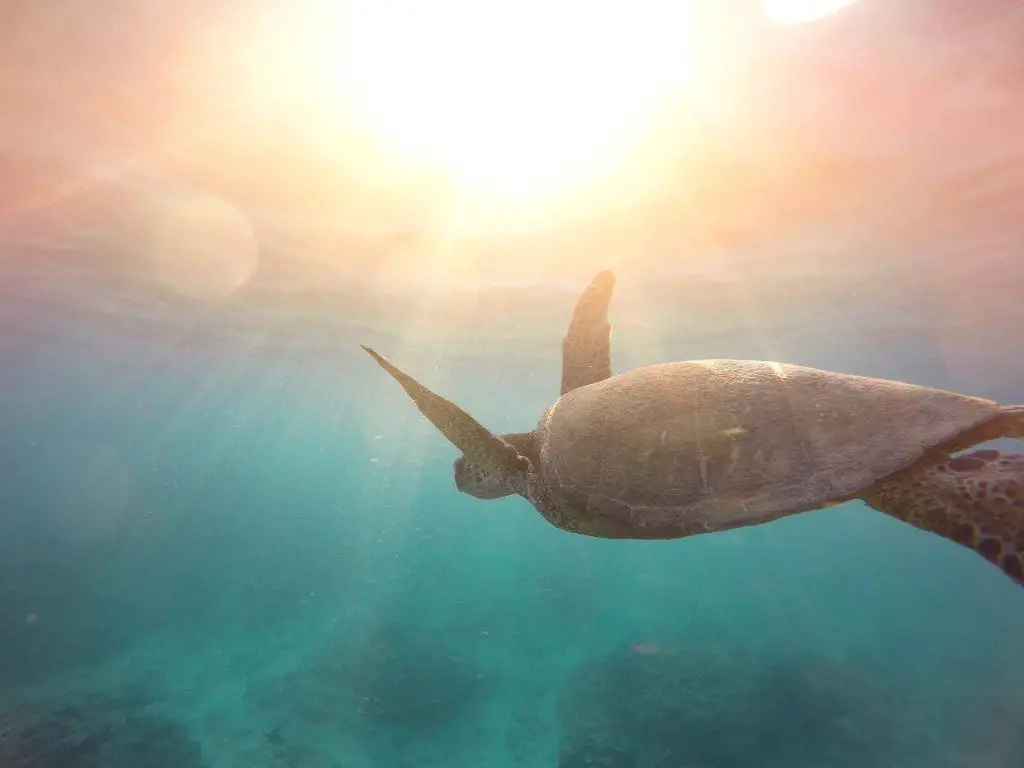
This sea turtle is a Natator depressus species that spend much of their time at the ocean’s surface and breeds only in Australia. Scientists named them for their uniquely flat shells.
They are located only from Northern Australia to Papua New Guinea Indonesia and have limited distribution.
Since they are occasionally on the ocean’s surface, birds use their shell as a small landing surface suitable for a break (Reef Catchments). Unlike other sea turtles, their young ones spend their time in murky water close to the shore.
They are mainly carnivorous, and their diet comprises sea cucumbers, soft corals, jellyfish, shrimp, and some seagrass.
The females are comparatively larger and with longer tails than the males during their adulthood. Their shell dominates a color that ranges from olive green to grey with a creamy inside.
They breed after 2-3 years, and their hatchlings become independent immediately after birth.
Unlike the other sea turtles, they do not migrate in the open oceans. They’re slower and defenseless on land, and they exist solely in shallow, soft-bottomed coastal waters.
Species Overview
- Order: Testudines
- Sub Order: Cryptodira
- Family: Cheloniidae
- Scientific Name : Natator depressus
- Weight: approximately 70-91 KG
- Size: 2.5 to 3.2 feet (0.8 to 1m)
- Population Estimate: approximately 20000-21000 nesting females
- Diet: sea cucumbers, soft corals, jellyfish, shrimp, seagrass.
- Threats of Survival: Loss of habitat, human threats through poaching and collection of eggs, pollution, and destruction of nesting beaches.
- Status: Listed as being data deficient on the IUCN’s Red List
6. Olive Ridley Sea turtle
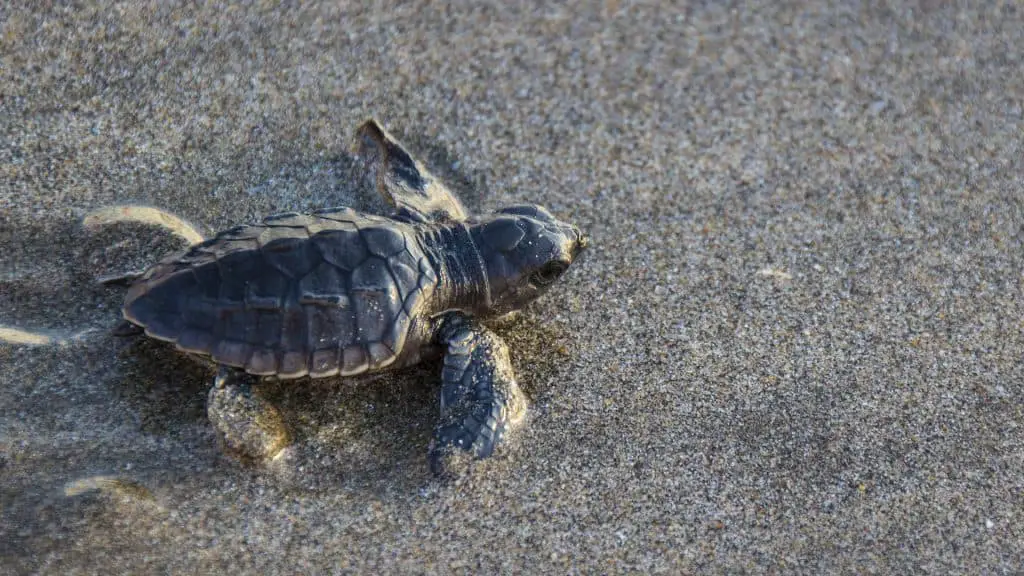
These species are named for the Olive green hue color of their carapace. They are comparatively small ocean turtles and the most typical sea turtles across the world’s oceans.
The females come ashore in large numbers to nest. They overwhelm their predators by gathering together in thousands and forming the Arribadas. The Arribadas are large groups of females that gather offshore and travel to the beach to nest all at once.
The Olive Ridleys spend most of their time in the open ocean, where they feed on jellyfish, snails, crabs, and shrimp on the surface. They can dive for more than 655 feet while in search of prey.
The female nests are located on tropical and subtropical beaches across the world. Most hatchlings perish as they head towards the ocean after hatching. Ghost crabs, dogs, raccoons, and birds are some of the predators that feed on these hatchlings.
Currently, their numbers are declining tremendously based on the population estimates for females and hatchlings gathered during the Arribadas.
Species Overview
- Order: Testudines
- Sub Order: Cryptodira
- Family: Cheloniidae
- Scientific Name : Lepidochelys olivacea
- Weight: about 85 pounds (39 kg)
- Size: approximately 2 to 2.5 feet (60 to 80 cm)
- Population Estimates: roughly 800,000 nesting females
- Diet: Jellyfish, snails, crabs, shrimps
- Threats of Survival: humans collecting eggs and hunting nesting females for their meat and skin and fishing nets
- Status: Considered as vulnerable to extinction in the IUCN’s Red List.
7. Hawksbill Sea turtle
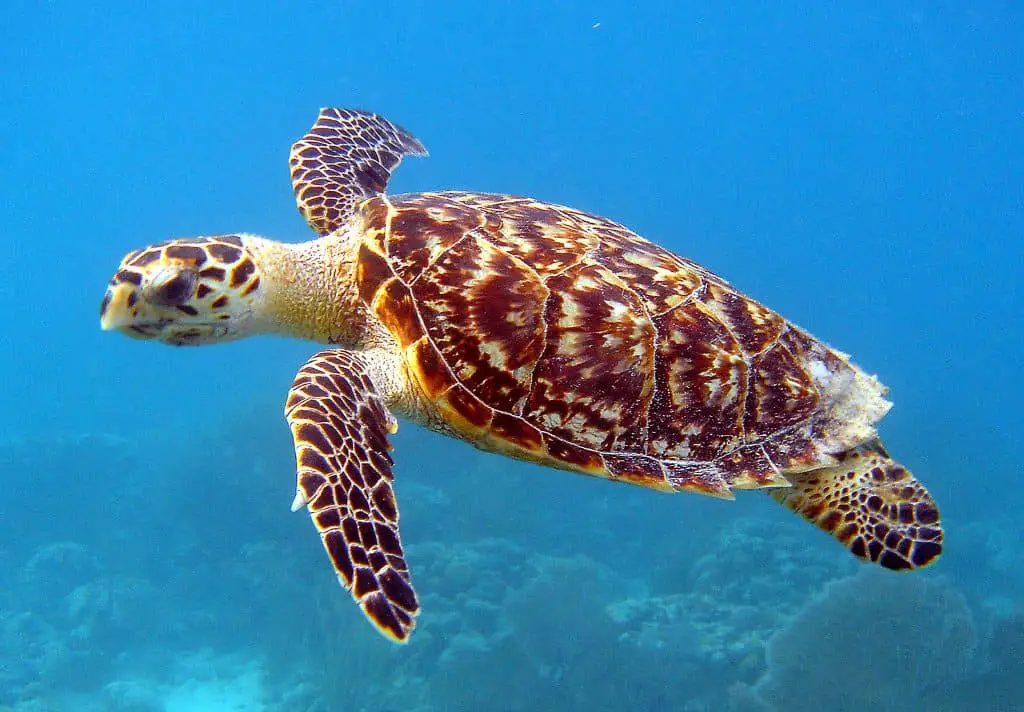
This species derives its name from its curved, hawk-shaped beaks. Their location is mainly tropical and subtropical waters throughout the world and mostly in coral reefs. Their attractive mottled shells are called tortoise shells, and they make them vulnerable for hunting.
They spend most of their time near coral reefs, where they use their narrow pointed beaks to extract sponges from the reefs and feed on them. A large percentage of their diets consist of sponges besides squid, shrimp, and algae.
They are crucial links in the marine ecosystems since they keep the coral reefs and seagrass beds healthy.
They are considered travelers in that they travel long distances from their feeding sites to the nesting grounds. The males rarely return to land after they enter the oceans as hatchings. The females usually return to the beach where they were born to nest and rekindle the hatching process.
Species Overview
- Order: Testudines
- Sub Order: Cryptodira
- Family: Cheloniidae
- Scientific Name: Eretmochelys imbricata
- Weight: just about 100 to 125 pounds (45 to 57 kg)
- Size: 2.5 to 3 feet (80 to 100 cm)
- Population Estimate: less than 20,000 nesting females
- Diet : sponges
- Threats to Survival: Illegal wildlife trade, fisheries bycatch, deteriorating nest and turtle habitat.
- Status : listed as critically endangered species under the IUCN Red List
8. Pacific Black Sea Turtle
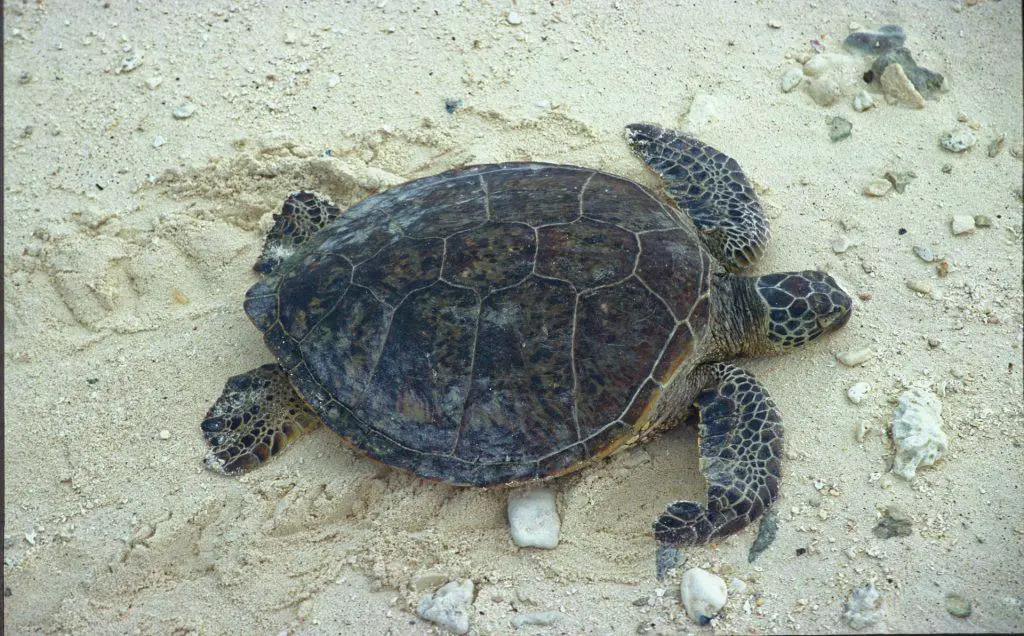
These turtles are currently classified under the same species as Green Sea Turtles. They have unique features that differentiate them from the green sea Turtle such, as a smaller size and a darker color. Their carapace has a shape that resembles a teardrop, unlike the green sea turtle, whose carapace is oval-shaped.
Unlike other sea turtles, their females nest in Galapagos Islands, and they can be spotted basking in the sun along with the Hawaii Islands. Besides Galapagos, their nesting grounds exist in Central America and Mexico.
Their diet is similar to that of the Green Turtle i.e. Marine plants which are mainly algae, seagrasses, and mangrove shoots. However, they can also feed on jellyfish and small fish. Since they are herbivorous, their predators are octopuses, pelagic fishes, and sharks.
Species Overview
- Order : Cryptodira
- Suborder : Cheloniidae
- Family : Cheloniidae
- Scientific name : Chelonia mydas agassizii
- Weight : Roughly 300 pounds
- Size : Close to 4 feet
- Population Estimate : more than 10,000 nesting females
- Threats of Survival: Poaching, over-exploitation, accidental bycatch in fishing gear and habitat destruction.
- Status : listed as endangered
Extinct Marine Turtles
9. Archelon Sea turtle
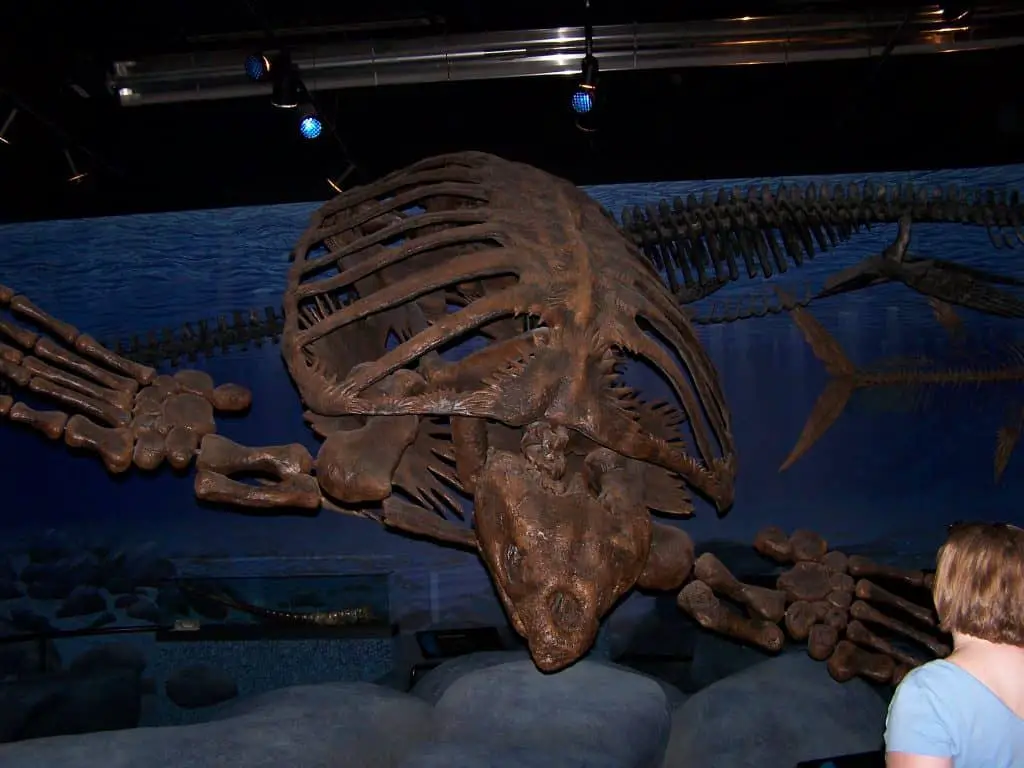
This is an extinct giant marine turtle that scientists discovered from fossilized remains in North American rocks. It belonged to the late Cretaceous epoch, i.e., between 100 -66 million years ago. An American Paleontologist, George Reber Wieland named it based on its skeleton and placed it into the extinct family, Prostestegidae. Its skeleton was found in South Dakota.
It’s the largest turtle ever in history. Their front feet developed into strong structures that could propel its body through the seas. Their skeleton specimen reveals a hooked and powerful beak. From the beaks, their diet appears to be large molluscs, e.g. squids that existed in the seas of their late Cretaceous epoch.
Studies estimated that they lived for 100 years and died while hibernating during the asteroid event 66 million yrs ago since they are partially buried in the mud of the seafloor. Their carapace was leathery and was thought to have featured a row of small ridges of roughly (20- 49 cm).
This species inhabited the Niobrara Sea, which involved the middle of the North American continent that separated the Rocky Mountains from the eastern half of the continent.
Species Overview
- Order: Chelonia
- Sub Order: Cryptodira
- Family: Protostegidae
- Scientific Name: Archelon ischyros
- Weight: Their estimated live weight ranges from 4500 pounds (2200 kg) to 11000 pounds.
- Size: Between 12 feet (35cm) and 15 feet (45cm)
- Reasons for Extinction: Shrinking of the seaway, cooling climate, increased egg and hatchling predation and the Asteroid Event.
10. Toxochelys Sea turtle
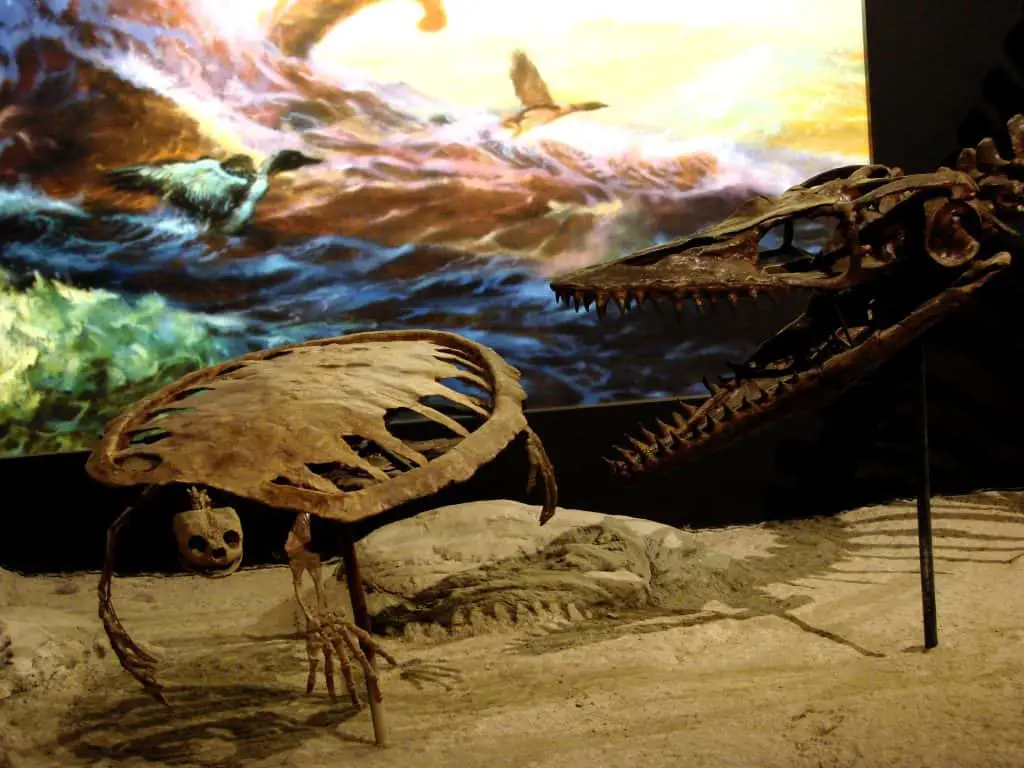
This is a commonly known genus of the Toxochelyidae family from the late Cretaceous period that went extinct by the late Eocene (37 – 56 million years ago). Their eyes sockets faced up and could possibly imply that these species, were bottom-dwellers. They were small to medium-sized, with round-shaped shells.
Their shells were frame-shaped with gaps between the bones and probably signified that they lived in the open ocean. Like the modern sea turtles, they ate seaweed, jellyfish, and floating carcasses. One Belgian naturalist Louis Dollo, confirmed that Hainosaurus fed on these species since their remains were found on their carcass.
Furthermore, their skulls indicated that they were also eaten by the larger Mosasaurs, initially by Tylosaurus and then by Mosasaurus and Prognathodon nearer the end of the Cretaceous. The Toxochelys lived in the Western Interior Sea, and their fossils are commonly found in the Smoky Hill Chalk, in Western Kansas.
Two species existed under the genus Toxochelys. They are: Toxochelys latiremis and Toxochelys moorevillensis.
Species Overview
- Order: Testudines
- Suborder: Cryptodira
- Family: Toxochelyidae
- Species: Toxochelys latiremis and Toxochelys moorevillensis
- Size: Roughly 200cm (6 feet)
- Reasons for Extinction: A biological catastrophe ,which was the asteroid event

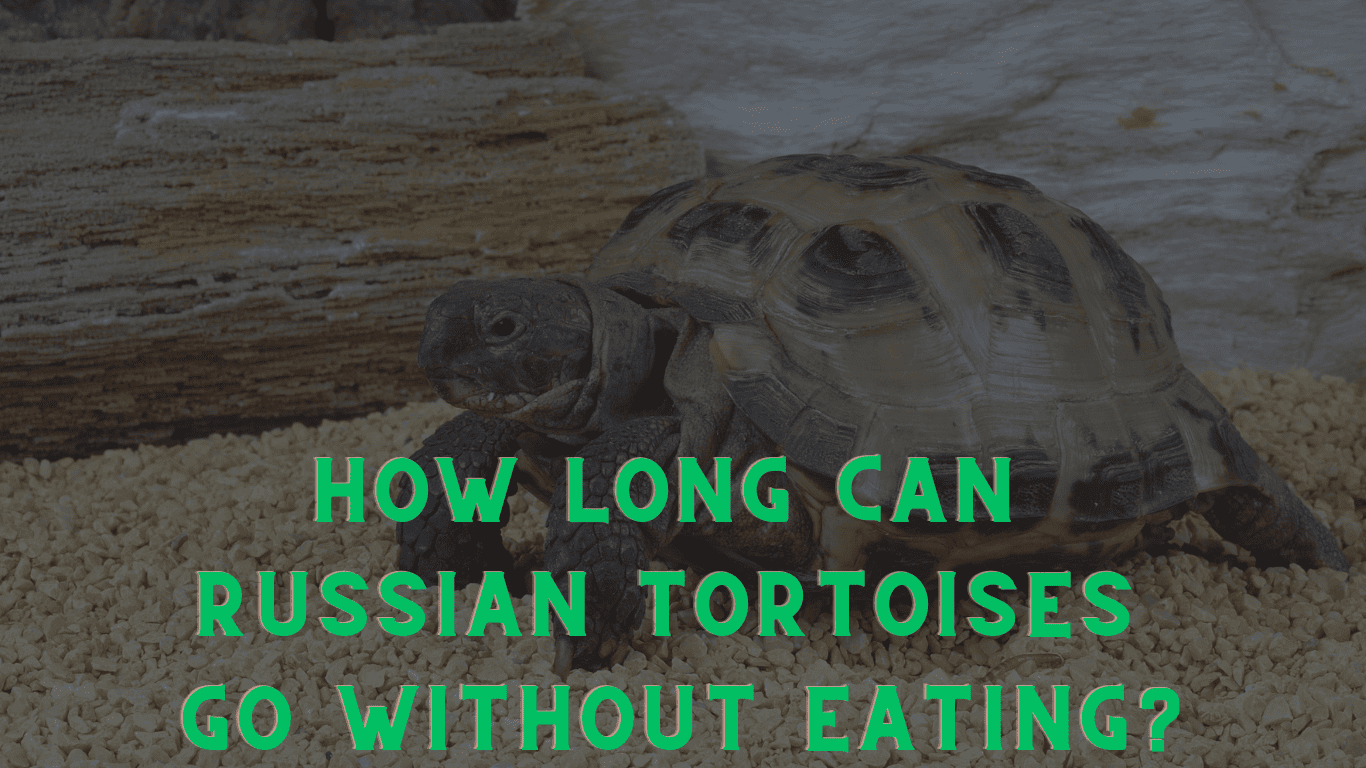
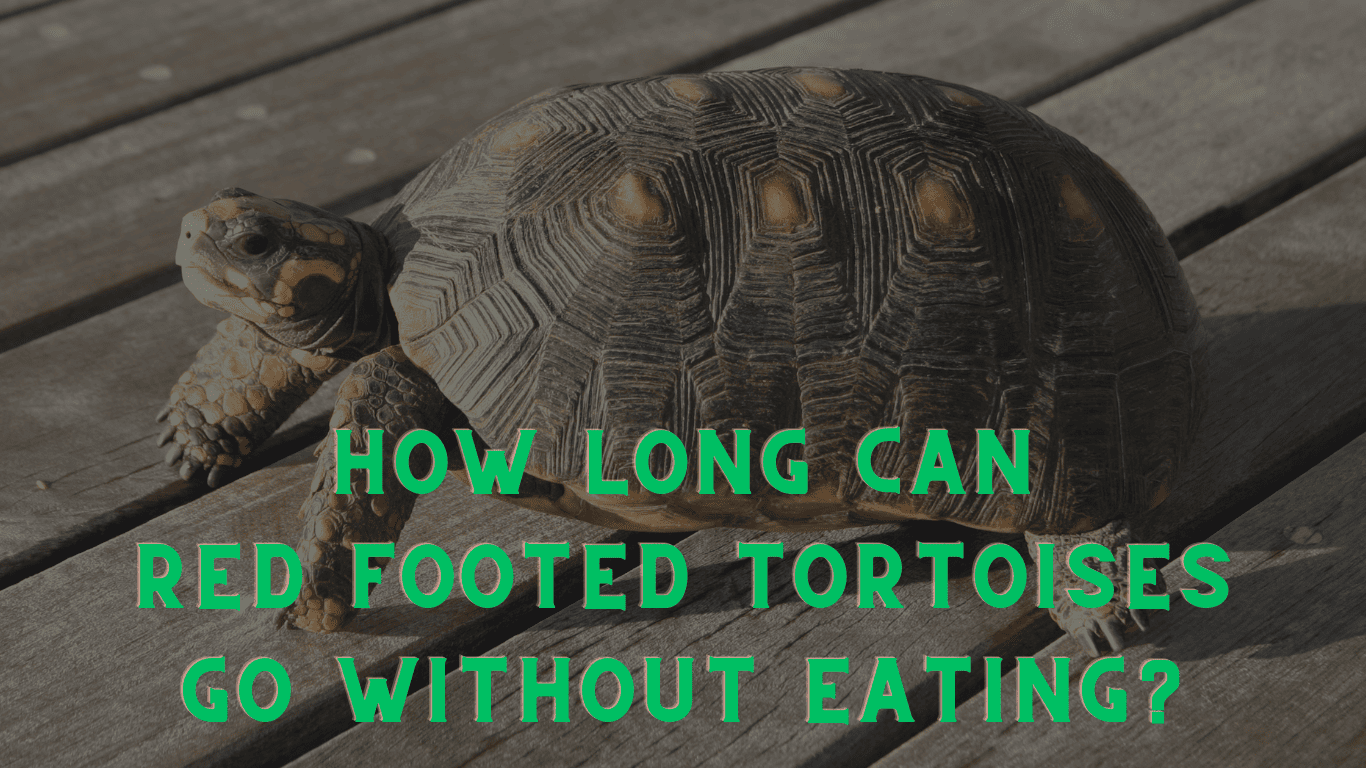

Leave a Reply